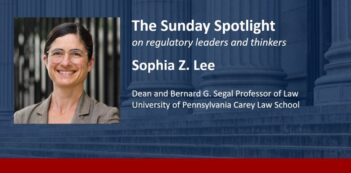
The Trump Administration violated administrative procedure to overhaul asylum policy.
On November 8, 2018, the Trump Administration announced a policy that prohibits individuals and families from applying for or being granted asylum if they arrive at the border irregularly—that is, at a location other than a port of entry. The policy, which conflicts with over fifty years of established immigration law, is morally troubling. The new asylum rule also illustrates the way this Administration has abused administrative law tools to create new policy.
“Asylum” is a legal term of art and form of protection spelled out in the Immigration and Nationality Act (INA). To qualify for asylum, a person must meet the definition of a “refugee,” which is defined in the INA as a person who has suffered persecution in the past or will face similar persecution in the future because of race, religion, nationality, political opinion, or membership in a particular social group. Under the INA, individuals can apply for asylum regardless of their immigration status or whether they enter the country legally or illegally.
The Trump Administration’s new asylum policy was published in the Federal Register as an interim final rule by the U.S. Department of Homeland Security (DHS) and U.S. Department of Justice. It was followed by a presidential proclamation issued by President Donald J. Trump affirming the new policy. The interim rule modifies existing regulations and prohibits individuals covered under a presidential proclamation from asylum eligibility. The proclamation states in part that “aliens who enter the United States unlawfully through the southern border in contravention of this proclamation will be ineligible to be granted asylum,” applies prospectively, and runs initially for a period of 90 days. Both the regulation and proclamation state that affected individuals could still apply for other forms of relief called “withholding of removal” and protection under the Convention Against Torture.
Before this interim rule, and consistent with the INA, anyone could applying for asylum, including those who entered at a place other than a port of entry.
Normally, rules published under the Administrative Procedure Act (APA) must undergo a period of notice and comment by the public before taking legal effect. Generally, the public comment period runs from 30 to 60 days. Many immigration policy changes have been issued using the notice and comment process. For instance, in October, DHS opened a 60-day comment period for its proposed change to the “public charge” rule, which would allow immigration officials to deny green cards and temporary visas to individuals they determined would be likely to receive government benefits.
The APA contains important exemptions to the notice-and-comment requirements. One exception applies for “interpretative rules, general statements of policy, or rules of agency organization, procedure, or practice.” Many immigration policies are issued as general statements of policy, such as memoranda on prosecutorial discretion and immigration enforcement priorities. A second exemption applies when the agency finds “good cause” to publish a rule without notice and comment because such a procedure is “impracticable, unnecessary, or contrary to the public interest.” When applying this exception, agencies must explain “good cause.” One example of good cause is when “immediate action is necessary to reduce or avoid health hazards or imminent harm to persons or property.”
The APA’s notice and comment requirements also do not apply to rulemakings involving “a military or foreign affairs function of the United States.”
The practical impact of invoking APA exceptions is that it allows rules and policies to go into effect immediately and without incorporating public input, which is precisely what happened with the Trump Administration’s recent asylum regulation.
When invoking the “good cause” exception, DHS and the Justice Department argued that providing notice and an opportunity for public comment “could lead to an increase in migration to the southern border to enter the United States before the rule took effect.” Migrants planning to enter the country illegally and make claims of credible fear when they are detained, the agencies reasoned, “would have an added incentive to cross illegally during the comment period.”
DHS and the Justice Department also argued that the APA’s “foreign affairs” exception applied. The agencies noted that “the flow of aliens across the southern border, unlawfully or without appropriate travel documents, directly implicates the foreign policy interests of the United States,” including “sensitive and ongoing negotiations with Mexico about how to manage our shared border.”
But neither of the government’s claims justifies disregarding the APA’s procedural requirements. The American Civil Liberties Union, Southern Poverty Law Center, and other groups have filed a lawsuit opposing the new asylum rule. The groups have challenged the rulemaking, in part, on APA grounds, arguing that the “foreign affairs” exception does not apply and that the government has not adequately shown “good cause” for avoiding notice-and-comment requirements.
Moreover, the rationale provided by the Administration for changing the asylum regulation is deeply flawed. There has been no “surge” of individuals at the southern border, as the Administration and news media have often publicized. One report reveals that the U.S. Border Patrol in 2018 apprehended 396,579 migrants, the fifth lowest number since 1973.
Furthermore, according to the Office of the United Nations High Commissioner for Refugees, there were 25.4 million refugees in the world by the end of 2017—“the highest ever seen.” The most recent data from DHS show that in Fiscal Year 2016, only 20,455 individuals were granted asylum, a drop in the bucket in contrast to the world refugee population. In addition, and based on my experience, the reasons individuals enter the United States irregularly are often related to their fear of return and desire for asylum, a protection they may be legally entitled to under the United States’ immigration statute.
In the Trump era, I have encountered dozens of individuals and families hailing largely from El Salvador, Guatemala, and Honduras crossing the border irregularly, and one theme is recurring: They are fleeing countries with high levels of violence and often fear returning to their home country. Asylum seekers who reach the border are resilient. But they often arrive having lived through trauma or without the sophistication to know what a designated port of entry even is—which, according to the United States’ own law, is not required to file an asylum claim.
The Administration should pull its recent asylum regulation and follow the immigration statute and existing regulations to ensure that any person who arrives in the United States and expresses a fear of return can apply for asylum.




